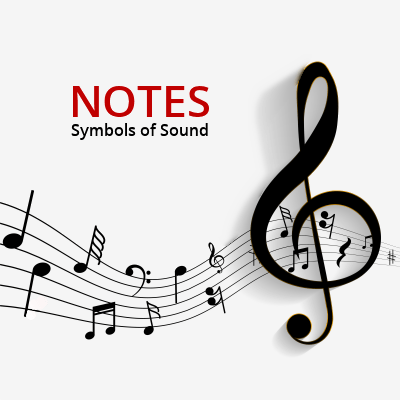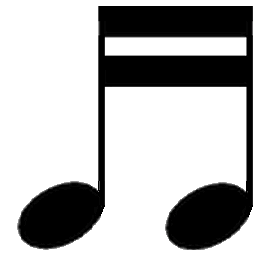
Reading & Interpretation of Notes The Symbols of Sound
After learning the symbols to starting a new composition, we continue with the symbols that make up the actual music, notes. Notes are placed on the lines and spaces of the staff to tell the performer which tones to play, when to play them, and how long each one lasts. How long a note's sound will last depends upon several factors such as the note's actual time value, the time-signature, and the tempo. The musician must mentally maintain a count of the beat to properly determine the note's actual duration. The musician must also keep in mind the key signature which tells them the pitch of certain notes in the composition. All this is required as well as keeping an eye on the conductor for the timing and any instructions as you go along

Identifying the Notes Determining the Tone
Some notes will carry a stem or a stem with flags. Both the stem and the flags tell the musician the time value of the notes. Notes are often connected together with beams making it easier to identify them more quickly. Whole notes, half-notes, and quarter-notes do not require flags or beams, any shorter note will. Each flag or beam on a note cuts it's time value in half. For example, an eighth-note with one flag becomes a sixteenth-note with two flags, a thirty-second-note with three and so forth. Some notes may have directions or ornamentation added to them for style during the composition; more on this later. In addition, other notes may be flipped or reversed in order to fit them onto the staff area.
Below are the Notes used in musical composing for your review. You can use the concert tone of your instrument to practice playing and timing the notes accordingly until you are familiar with identifying and timing the notes. This will make it easier for you when reading a score or piece of music later.

The semibreve' or whole-note has a duration of one measure or bar. Play for one full count of a measure. The whole-note has no stem.

The breve' or double-whole-note has a duration of two measures or bars. Play for two full counts of a measure. The breve' has no stem.

The quadruple-whole-note has a duration of four measures or bars. Play for four full counts of a measure.

The octuple-whole-note has a duration of eight measures or bars. Play for eight full counts of a measure.

The minum or half-note has a duration of one-half measure or bar. Play for one-half of the full count of a measure.

The crochet or quarter-note has a duration of one-quarter measure or bar. Play for one-quarter of the full count of a measure.

The quaver or eighth-note has a duration of one-eighth measure or bar. Play for one-eighth of the full count of a measure.

The sixteenth-note has a duration of one-sixteenth measure or bar. Play for one-sixteenth of the full count of a measure.

The thirtysecond-note has a duration of one-thirtysecond measure or bar. Play for one-thirtysecond of the full count of a measure.

The sixtyfourth-note has a duration of one-sixtyfourth measure or bar. Play for one-sixtyfourth of the full count of a measure.

The dotted-note tells you to extend the note by one-half of it's normal time value. For example, if a note lasts for two counts, then the performer is to add one count (extending the note by half its time value) and play the note for 3 counts.


